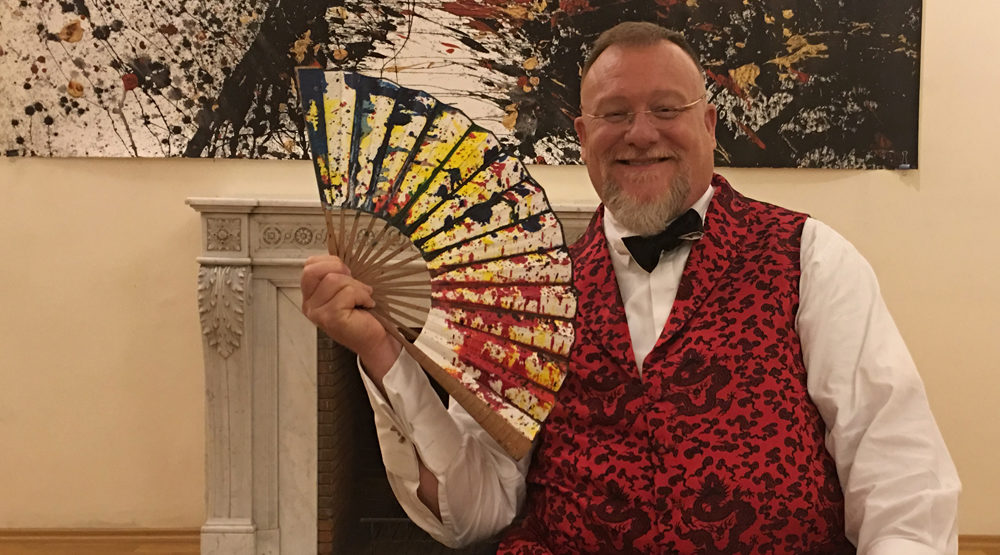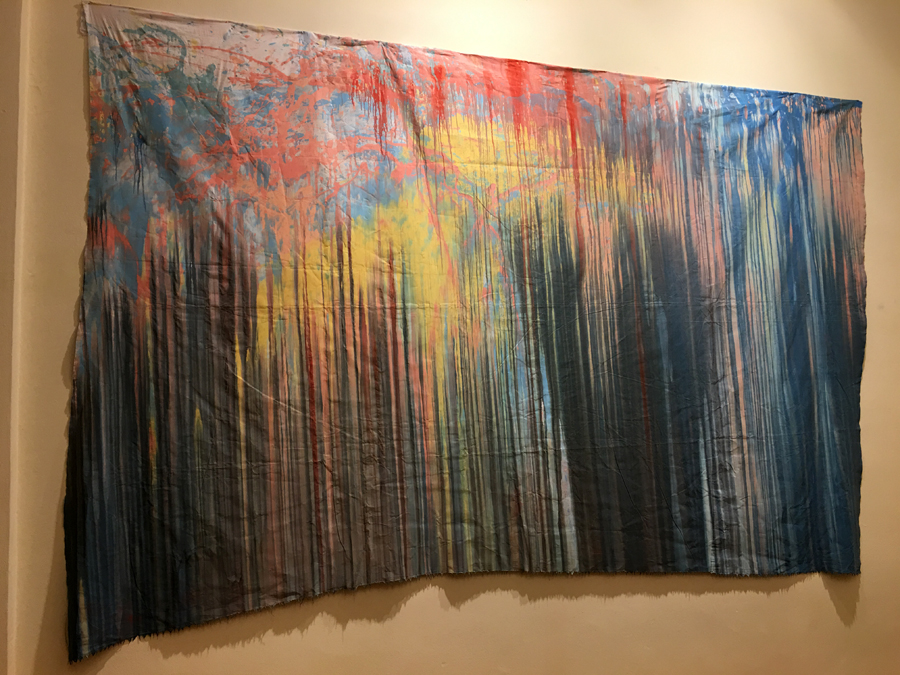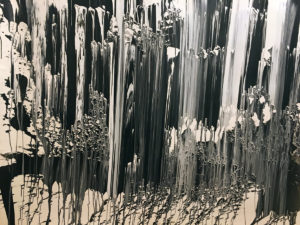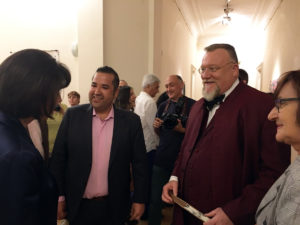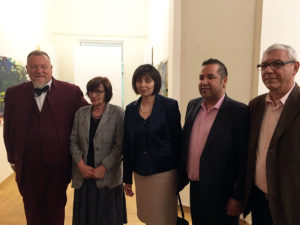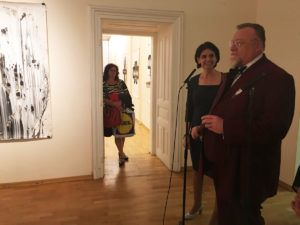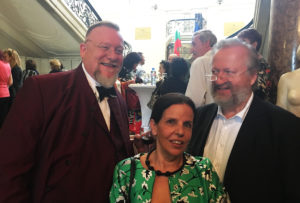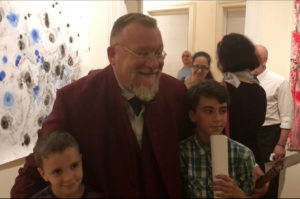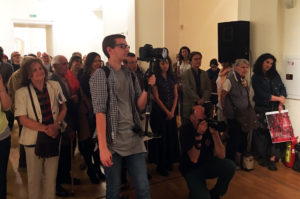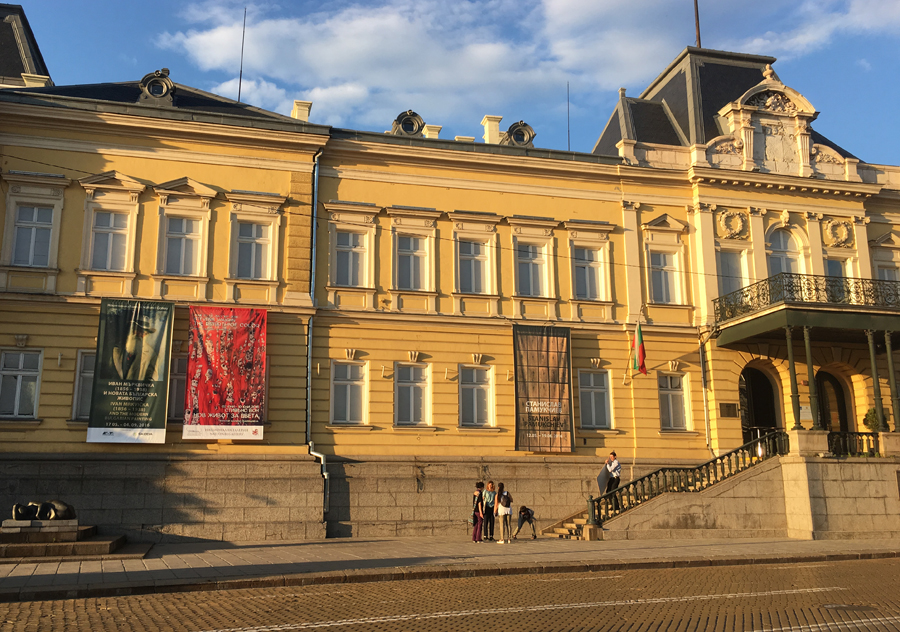Stevens Vaughn
Hafnia Foundation
National Art Gallery, Sofia
June-July 2016
Calligraphy of water
by Massimo Scaringella
“Creation lives as genesis under the visible surface of the work”, Paul Klee
The creative process is not social, but strictly individual: one looks and finds that form and color are metaphors for space and life, rather than ideological allusions or revealed truths. And this is why that which is represented is worthy of our greatest attention for its own reasons and for itself. The work of art is usually, of course, a container of forces and tensions that are only soothed by the open contact of the observer who is aware of the charm of the artist’s uneasiness, where each gear in the articulated creative structure constitutes, through matter and color variations, a strong evocative, emotional association that carries us beyond the image of the work itself.
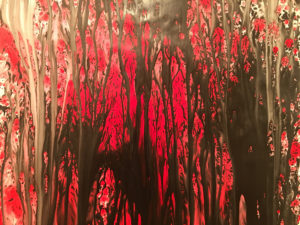
Painting is the most widely used method of expression, the most authentic and natural and, at the same time, the most abstract – pure meaning in which the creativity of form is emphasized, following its genesis step by step. Paul Klee has said: “…in the beginning, there may be action, but it is in turn subordinate to the idea”. Therefore, to the artist the work stands for an experimental, spontaneous moment of the creative ideation, where the artist clearly testifies to the formation of the image, of sign as writing that, coming out of the unconscious, becomes visual thought.
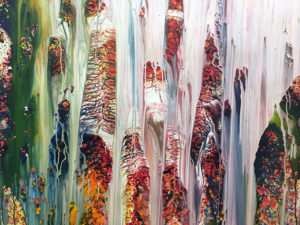 “A painting is not a picture of an experience, it is an experience.” We could draw on this thought by Mark Rothko to describe Stevens Vaughn’s work, which conveys the meaning of a visual essentiality, only apparently confusing, but structurally associated with an ironic and colorful view, expressing with its irrepressible sign a misleading gestural line, guided by a manual drive that is full of emotional and cultural expressionism that belongs in a sound reality. The structure or, better still, the ‘ritualism’ of each work is composed as the expression of a non-verbal thought, transformed into an articulated structure based on the revelation of reality, where a stylistic exercise capable of turning desire into the irony of creativity joins a deferred dilation of time and space. Patches, rapid straining and chromatic hauteurs contain the definition of space, contending against nature and poetry for the search of formal solutions for their work, which end up in a disturbing use of such a primary element as water.
“A painting is not a picture of an experience, it is an experience.” We could draw on this thought by Mark Rothko to describe Stevens Vaughn’s work, which conveys the meaning of a visual essentiality, only apparently confusing, but structurally associated with an ironic and colorful view, expressing with its irrepressible sign a misleading gestural line, guided by a manual drive that is full of emotional and cultural expressionism that belongs in a sound reality. The structure or, better still, the ‘ritualism’ of each work is composed as the expression of a non-verbal thought, transformed into an articulated structure based on the revelation of reality, where a stylistic exercise capable of turning desire into the irony of creativity joins a deferred dilation of time and space. Patches, rapid straining and chromatic hauteurs contain the definition of space, contending against nature and poetry for the search of formal solutions for their work, which end up in a disturbing use of such a primary element as water.
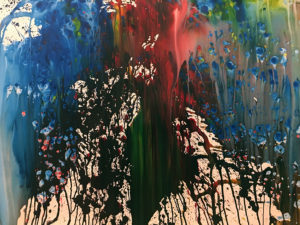 The artist with his gestures establishes a relationship with life in a kind of mythical ritual, inherited from his experiences in China and Japan, changing the way of seeing beyond aesthetic expression in a fantastic privileged condition. Because he does not look outside, but inside. Inside his origins, inside his self, choosing the ideal gesture, the ideal form, among proportions to be challenged, coors to be exhibited and dream-like signs to be exalted.
The artist with his gestures establishes a relationship with life in a kind of mythical ritual, inherited from his experiences in China and Japan, changing the way of seeing beyond aesthetic expression in a fantastic privileged condition. Because he does not look outside, but inside. Inside his origins, inside his self, choosing the ideal gesture, the ideal form, among proportions to be challenged, coors to be exhibited and dream-like signs to be exalted.
In making art, Stevens Vaughn always uses, as a ritual, the dripping technique, which does not imply throwing color in a casual way. On the contrary, it means, based on an experienced search, distributing each drop of pigment following a naturally relative order where the unsteadiness of the free-flowing spout can give rise to different figures: it can break into small drops, it can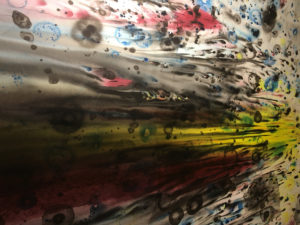 splash according to the impact on the surface but always in a balanced manner or, as in some of his latest works, the folds of the paper may determine the color surface. Whatever the case may be, he never surrenders anything to style or to the viewer’s expectations, but only to the unyielding and patient journey of color, often diluted with water, hence becoming quicker, on the spotless sheets of paper, expressing a search for something that is, that exists. Often there is not even a story to be described, but the interior of the image is reached straightaway, coupling technique with the expressive demand of vision.
splash according to the impact on the surface but always in a balanced manner or, as in some of his latest works, the folds of the paper may determine the color surface. Whatever the case may be, he never surrenders anything to style or to the viewer’s expectations, but only to the unyielding and patient journey of color, often diluted with water, hence becoming quicker, on the spotless sheets of paper, expressing a search for something that is, that exists. Often there is not even a story to be described, but the interior of the image is reached straightaway, coupling technique with the expressive demand of vision.
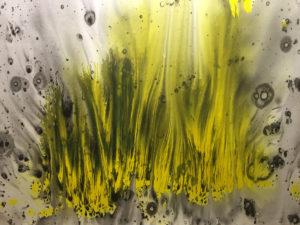 With the construction and deconstruction of forms that are set free from their role of expressing a concept, Stevens Vaughn’s quick gestures represent a point of arrival, a definition of form itself with enduring attempts to acknowledge an inner, parallel reality. Thus a poetic dimension emerges where space, movement, rhythm, light and vibration are elements that can be referred to objective, emotional spaces in a dream vision in which, once again, the sign is no longer entrusted to pure instinct but to a creative, structured demand.
With the construction and deconstruction of forms that are set free from their role of expressing a concept, Stevens Vaughn’s quick gestures represent a point of arrival, a definition of form itself with enduring attempts to acknowledge an inner, parallel reality. Thus a poetic dimension emerges where space, movement, rhythm, light and vibration are elements that can be referred to objective, emotional spaces in a dream vision in which, once again, the sign is no longer entrusted to pure instinct but to a creative, structured demand.
Color, that element producing and discovering forms, allows chromatic tones to be transformed according to view. This tone-based relationship between the sheet’s white surface and color causes a unique vibration, a shrill clarity suggesting a vital removal of elements. The outcome essentially arises out of a clear intersection between compositional integrity and balance, where the unit, a key aspect to his work, is conquered through a composition in which elements are wisely arranged in space by means of an interrelation that expands the organic development of form.
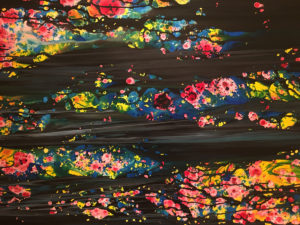 In this phase of his work, Stevens Vaughn wants to persuade us of the exciting and at the same time provocative idea that making art is engaging in the anarchy of a lack of structure. But paradoxically, these works, full of light and color, take us back to a concrete view of today’s world, where the artist is perfectly aware of the assimilation resulting from the various cultural exchanges that occurred throughout his educational and creative journey.
In this phase of his work, Stevens Vaughn wants to persuade us of the exciting and at the same time provocative idea that making art is engaging in the anarchy of a lack of structure. But paradoxically, these works, full of light and color, take us back to a concrete view of today’s world, where the artist is perfectly aware of the assimilation resulting from the various cultural exchanges that occurred throughout his educational and creative journey.
Bearing witness to the fact that art is still the only existential segment today between human hope and poetry, we can claim, as Gillo Dorfles has, that “ the so-called abstractism does not exist at all. Everything exists already in the infinite field of nature”.
Water is a color
by Qin Jian
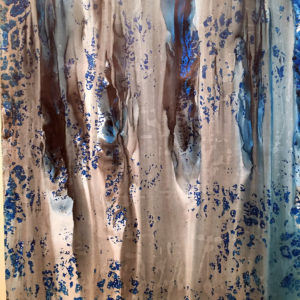 Water and ink feature two primary means of media in traditional Chinese ink and wash painting. It seems as if brush touch and color are creations of ink. In an underlying sense, however, they are produced by incessantly flowing water. As the carrier of ink, water endows lines and forms with magic power. It is dynamic. The water-absorbing quality of rice paper applied in Chinese ink and wash painting conforms to the dynamic quality of water, allowing greater space of expression. Drip the ink with water on rice paper, the ink dot would spontaneously extend and vary in form.
Water and ink feature two primary means of media in traditional Chinese ink and wash painting. It seems as if brush touch and color are creations of ink. In an underlying sense, however, they are produced by incessantly flowing water. As the carrier of ink, water endows lines and forms with magic power. It is dynamic. The water-absorbing quality of rice paper applied in Chinese ink and wash painting conforms to the dynamic quality of water, allowing greater space of expression. Drip the ink with water on rice paper, the ink dot would spontaneously extend and vary in form.
As a reproduction of the artistic conception for space from a metaphysical perspective, the notion in Chinese painting that “the grandest image has no fixed form” refers to the intuitional experience and under- standing towards nature. Forms in paintings are no longer confined by detailed portrait of an exact object, but they are representatives of the image at the painter’s deep heart.
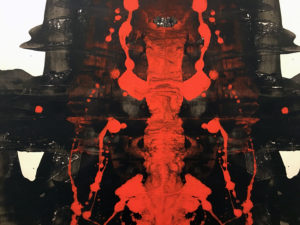 Compared with figurative depiction that focuses on what one sees, image expression concerns more with the experience and perception of the mind. Moreover,the latter concentrates further on the development that conception and behaviour invest in practice. Both form and color in an image are highly brief. Water not only resolves the seemingly connected relation between form and reality, but also makes it possible for the painter to conduct image expression in the meta- physical space.
Compared with figurative depiction that focuses on what one sees, image expression concerns more with the experience and perception of the mind. Moreover,the latter concentrates further on the development that conception and behaviour invest in practice. Both form and color in an image are highly brief. Water not only resolves the seemingly connected relation between form and reality, but also makes it possible for the painter to conduct image expression in the meta- physical space.
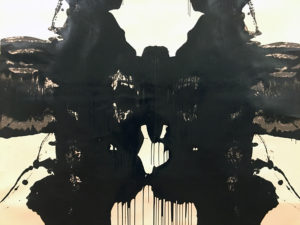 Having been in China for many years, Stevens gradually accumulates knowledge in traditional Chinese culture and art, participating in multiple related activities as a natural result. His interest lies in flexible substances. He once invited over 20 art college students to visit his garden at Gulangyu Island and collaborate on one painting, which stretches approximately five meters. Each occupying one position before the paper, the students selected their favorite colors to paint at random, yet none of them could control or predict the painting process and its result. Half an hour later, the pouring rain suddenly fell. All the students sought shelter in the house. It then rained even more heavily. Piles of pigments in different colors flew on the paper under the effect of the rainwater. Forms and colors disappeared and meanwhile gave rise to new scenes.
Having been in China for many years, Stevens gradually accumulates knowledge in traditional Chinese culture and art, participating in multiple related activities as a natural result. His interest lies in flexible substances. He once invited over 20 art college students to visit his garden at Gulangyu Island and collaborate on one painting, which stretches approximately five meters. Each occupying one position before the paper, the students selected their favorite colors to paint at random, yet none of them could control or predict the painting process and its result. Half an hour later, the pouring rain suddenly fell. All the students sought shelter in the house. It then rained even more heavily. Piles of pigments in different colors flew on the paper under the effect of the rainwater. Forms and colors disappeared and meanwhile gave rise to new scenes.
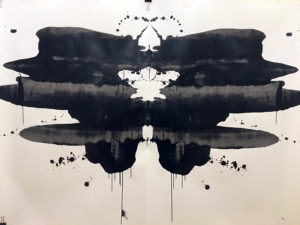 Unexpected spaces compromised by colors came into being during the water movement. Holding an umbrella, Stevens sat up beside the painting as if watching another painter work. He enjoyed the creating process launched by water. Entitled “water is color”, the workshop on the rainy day was practically carried out by Stevens on purpose. This series constitutes part of his current painting practice. The role that water plays has to do with the balance between the controlled and the uncontrolled. According to the Chinese painting history, the uncontrolled implies permission for the other’s voluntary intervention and participation in creation, including media such as water, brush, ink and paper. It is a spiritual realm far beyond technique: to discover and present the existence of Self within No Self. Ever since 2013, Stevens abstained from using brush. As a substitute, he cast pigments to the paper and washed out the form and the color with abundant water in most cases.
Unexpected spaces compromised by colors came into being during the water movement. Holding an umbrella, Stevens sat up beside the painting as if watching another painter work. He enjoyed the creating process launched by water. Entitled “water is color”, the workshop on the rainy day was practically carried out by Stevens on purpose. This series constitutes part of his current painting practice. The role that water plays has to do with the balance between the controlled and the uncontrolled. According to the Chinese painting history, the uncontrolled implies permission for the other’s voluntary intervention and participation in creation, including media such as water, brush, ink and paper. It is a spiritual realm far beyond technique: to discover and present the existence of Self within No Self. Ever since 2013, Stevens abstained from using brush. As a substitute, he cast pigments to the paper and washed out the form and the color with abundant water in most cases.
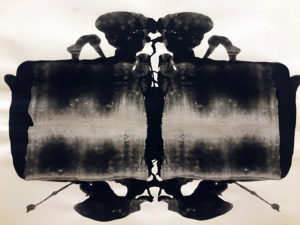 The uncontrolled method permitted the variance of space on the paper. In a certain period of 2014, Stevens gave up color and employed merely black ink, intending to experience the “ink is color” theory in Chinese painting philosophy by his own study. (According to the Chinese painting philosophy, the ink comprises five colors.) Compared with pigments, the ink contains more water and thus the sensibility and uncertainty in its generation. The ink dots on the paper are ended up by being resolved or removed. While the continuously dripping ink is constantly removed by water, the space relation is released consequently, simple yet changeable. Stevens always addresses his practice as “play-seeking” which bears a remarkable similarity with the Yipin theory in Chinese painting philosophy, which suggests the ultimately extraordinary stage the artistic skill or art work achieves.
The uncontrolled method permitted the variance of space on the paper. In a certain period of 2014, Stevens gave up color and employed merely black ink, intending to experience the “ink is color” theory in Chinese painting philosophy by his own study. (According to the Chinese painting philosophy, the ink comprises five colors.) Compared with pigments, the ink contains more water and thus the sensibility and uncertainty in its generation. The ink dots on the paper are ended up by being resolved or removed. While the continuously dripping ink is constantly removed by water, the space relation is released consequently, simple yet changeable. Stevens always addresses his practice as “play-seeking” which bears a remarkable similarity with the Yipin theory in Chinese painting philosophy, which suggests the ultimately extraordinary stage the artistic skill or art work achieves.
“Play-seeking” is the attitude that runs through Steven’s art initiatives.




